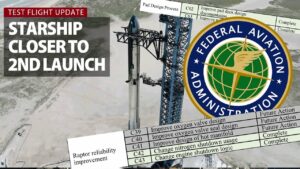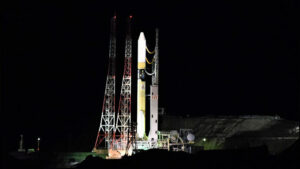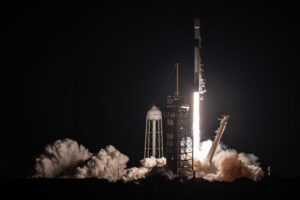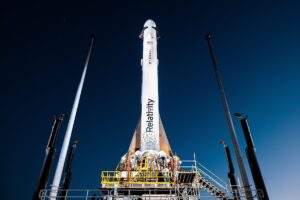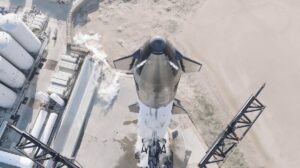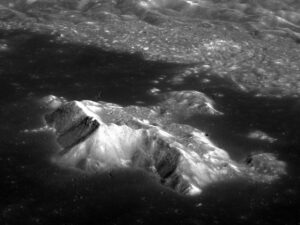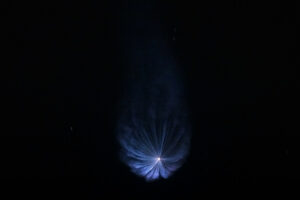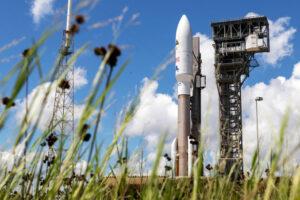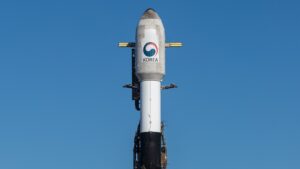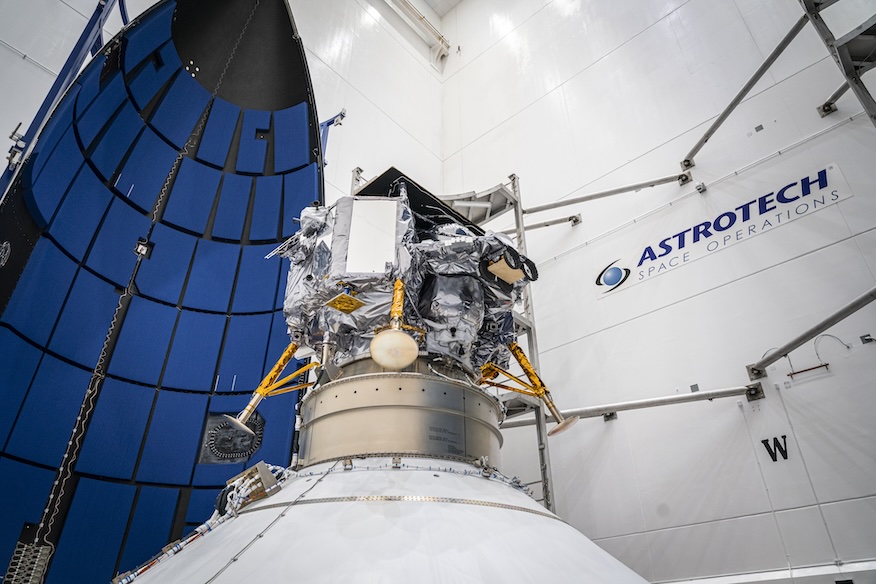
A gold-plated tracker, an imager searching for surface water and an radiation detector are among the suite of five instruments flying on board one of NASA’s first missions to the Moon’s surface since the Apollo 17 mission in 1972.
Researchers and officials with the agency’s Commercial Lunar Payload Services Program (CLPS) outlined the NASA-sponsored payloads on board Astrobotic’s lunar lander. It’s set to launch onboard the maiden flight of United Launch Alliance’s (ULA) Vulcan rocket.
“This whole task is not easy. Landing on the Moon is extremely difficult,” said Chris Culbert, the CLPS program manager at NASA’s Johnson Space Center. “We recognize that success cannot be assured. The surface of the Moon hold many robotic spacecraft that were not able to land softly and complete there missions.”
Among the 20 total payloads manifested on the Peregrine Mission 1 lander are the following:
- Laser Retroreflector Array (LRA) – Goddard Space Flight Center
- Neutron Spectrometer System (NSS) – Ames Research Center
- Linear Energy Transfer Spectrometer (LETS) – JSC
- Near-Infrared Volatile Spectrometer System (NIRVSS) – ARC
- Peregrine Ion-Trap Mass Spectrometer (PITMS) – GSFC
“The particular suite of payloads on Peregrine 1 have some interesting synergies that will make important contributions to lunar science and exploration,” said Paul Niles, the CLPS project scientist at NASA. “Three of our instruments will collect data on lunar volatiles using different techniques. Two instruments will provide perspectives on the radiation environment at the lunar surface, helping us better prepare us to send crewed missions back to the Moon.”
“We’ll also learn information about the composition of the surface by evaluating its mineralogy,” he added.
[embedded content]
Culbert noted that some of the instruments flying onboard Peregrine have either duplicates planned for other CLPS missions or follow-on science that will be featured on other landers.
One of those is the NIRVSS payload, which is a combination of a near-infrared spectrometer, a multi-color imager and a four-channel temperature sensor. Together, they will study volatiles, like water that may change in its state of mater depending on the temperature. A future copy will launch onboard NASA’s Volatiles Investigating Polar Exploration Rover (VIPER), which is set to launch in late 2024.
“These measurements will help us understand more broadly how water might migrate across the lunar surface, making its way from low latitudes, where the Peregrine mission is going to higher latitudes near the poles, where there are permanently shadowed craters,” said Tony Colaprete, the principle investigator for NIRVSS.
He added that in addition to measuring water, NIRVSS, along with other instruments, is expected to measure a wide range of volatiles while on the Moon’s surface. He noted that things like carbon dioxide and methane are possible as well as sulfur-bearing compounds, like hydrogen sulfide an sulfur dioxide.
“We will also be able to look at hydroxyl with the NIRVSS instrument. Hydroxyl is like water, just short a hydrogen atom. It’s OH, but it can be bound chemically into the regolith matrix and so actually be stable at much higher temperatures,” Colapret explained. “We’ll be able to sort out what’s water, H2O, and what’s hydroxyl, OH.”
Another instrument that will be shared across multiple CLPS payloads is the LRA, an instrument with no active functions, but an important tool designed to help create a marker for landers not only from the U.S., but also from other country’s space agencies.
Daniel Cremons, the principle investigator for the LRA payload, described it as having “a hemispherical array of special glass prisms called ‘retro-reflectors,’ which return light back towards the illumination source.”
“The same phenomenon causes cats’ eyes to shine in the darkness and road markers to light up under a car’s headlights,” Cremons explained. “On a CLPS lander, LRA acts as a precise marker of the lander position that will be visible under illumination from a laser ranging system onboard an orbiting or landing spacecraft.”
In response to a question from Spaceflight Now on Thursday, Cremons said that the LRA’s that are flying on the lunar landers from other countries were derived from international agreements between NASA and the pertinent international space agency that are unrelated to the Artemis Accords.
Controversy over cremation payload
NASA’s payloads, while some of the key highlights of the Peregrine Mission 1 flight, are not the only passengers grabbing attention for this mission.
Celestis Memorial Spaceflights has two payloads flying on the Vulcan rocket. The Enterprise Flight, featuring the ashes of ‘Star Trek’ creator Gene Roddenberry and stars James Doohan and Nichelle Nichols, will be launched to a heliocentric orbit around the Sun. The company’s other payload, called the Tranquility Flight, will also feature the cremated remains of a collection of people.
"From the age of 12, he dedicated his life to enabling humans to “get off this little rock” to be “a space-faring civilization.”
💙 We are honored to have the ashes of Astronaut Philip Chapman aboard the upcoming Celestis Enterprise flight. Join him in this journey to deep space! pic.twitter.com/lnFzHpbSYJ— Celestis, Inc. 🚀 Memorial Spaceflights (@celestisflights) December 28, 2023
That second payload was the impetus of a letter sent by Navajo Nation President Buu Nygren to NASA and the U.S. Department of Transportation. Native News Online was the first to report about the Dec. 21, 2023, letter.
During Thursday’s teleconference, Joel Kearns, the deputy associate administrator for Exploration and the Science Mission Directorate, addressed the letter to state that CLPS missions are not formally NASA missions and therefore, NASA doesn’t have final say over all the payloads that are flown by their commercial partners.
“With those new opportunities and new ways of doing business, we recognize that some non-NASA commercial payloads can be a cause for concern to some communities,” Kearns said. “And those communities may not understand that these missions are commercial and they’re not U.S. government missions, like the ones that we’re talking about.”
He added that an intergovernmental meeting, supported by NASA, will be set up with the Navajo Nation. Kearns didn’t elaborate on when the meeting will take place, who will be in attendance or if the meeting will be made public in any way.
The letter by Nygren asked for Peregrine Mission 1 to be delayed, but there don’t appear to be any indications that that will occur.
Vulcan ready to fly
Thursday also brought news that ULA’s Vulcan rocket went through the Launch Readiness Review (LRR) and is ready for its first flight. The evaluation was led by ULA Launch Director Tom Heter III at the Advanced Spaceflight Operation Center (ASOC) at Cape Canaveral Space Force Station. The rocket rolled to the launch pad on Friday morning.
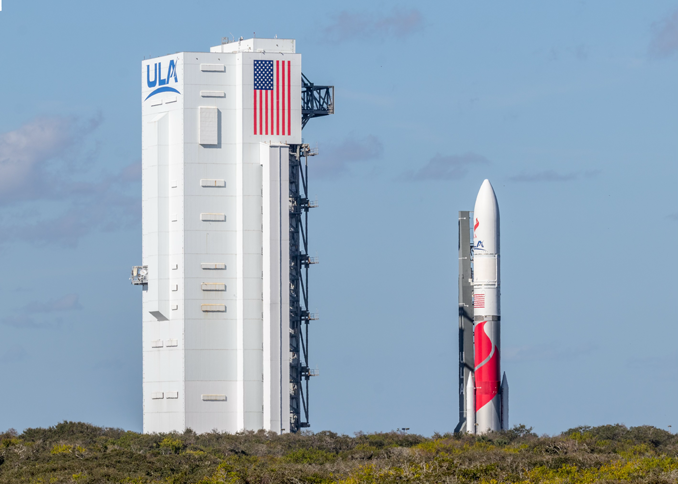
The rocket is flying in a VC2S configuration with the designation of V-001, according to ULA. That means that it has two solid rocket boosters and is flying a short payload fairing.
This will be the first certification mission (Cert-1) for the rocket out of two needed before it can start flying National Security Space Launch (NSSL) missions for the U.S. Space Force. Liftoff is set during a 45-minute launch window that opens at 2:18 a.m. EST (0718 UTC) the morning of Jan. 8.
The rocket will be powered by a pair of Blue Origin BE-4 engine on the Vulcan booster stage and a pair of RL10C-1-1A engines from Aerojet Rocketdyne on the Centaur 5 upper stage. Starting in 2025, the Centaur 5 will use RL10C-X engines, which feature a 3D-printed combustion chamber.
“3D printing enables Aerojet Rocketdyne to manufacture the copper chamber in much less time than it takes to build our traditional tube-walled chamber,” said George Prueger, senior director of RL10 programs, said in a statement. “That will enable Aerojet Rocketdyne to dramatically increase production rates while reducing costs.”
Aerojet Rocketdyne is also contributing 12 MR-107 attitude-control thrusters along with pressurized helium tanks for the vehicle.
- SEO Powered Content & PR Distribution. Get Amplified Today.
- PlatoData.Network Vertical Generative Ai. Empower Yourself. Access Here.
- PlatoAiStream. Web3 Intelligence. Knowledge Amplified. Access Here.
- PlatoESG. Carbon, CleanTech, Energy, Environment, Solar, Waste Management. Access Here.
- PlatoHealth. Biotech and Clinical Trials Intelligence. Access Here.
- Source: https://spaceflightnow.com/2024/01/05/nasa-discusses-moon-bound-science-as-ulas-vulcan-rocket-gets-go-ahead-for-jan-8-launch/
- :has
- :is
- :not
- :where
- $UP
- 000
- 1
- 12
- 17
- 20
- 2023
- 2024
- 2025
- 220
- 28
- 360
- 678
- 8
- a
- Able
- About
- above
- According
- across
- active
- acts
- actually
- Adam
- added
- addition
- addressed
- advanced
- age
- agencies
- agency
- agreements
- ahead
- All
- Alliance
- along
- also
- among
- an
- and
- any
- apollo
- appear
- ARE
- around
- Array
- Artemis
- AS
- Assembly
- Associate
- assured
- astronaut
- At
- atom
- attendance
- attention
- back
- BE
- before
- Better
- between
- Blue
- blue origin
- board
- booster
- BOOSTERS
- bound
- broadly
- brought
- build
- Building
- business
- but
- by
- called
- CAN
- cannot
- cape
- carbon
- carbon dioxide
- carry
- Cause
- causes
- Center
- Certification
- Chamber
- change
- Chris
- collect
- collection
- combination
- commercial
- Communities
- Company’s
- complete
- composition
- Concern
- Configuration
- content
- contributing
- contributions
- Copper
- Costs
- countries
- country’s
- create
- creator
- data
- dec
- dedicated
- deep
- Delayed
- Department
- department of transportation
- Depending
- deputy
- Derived
- described
- designation
- designed
- different
- difficult
- Director
- Doesn’t
- doing
- Dont
- dramatically
- duplicates
- during
- earth
- easy
- either
- Elaborate
- embedded
- enable
- enables
- enabling
- encapsulated
- energy
- Engine
- Engines
- Enterprise
- Environment
- evaluating
- evaluation
- expected
- explained
- exploration
- extremely
- Eyes
- Feature
- featured
- Featuring
- final
- First
- five
- flight
- flying
- following
- For
- Force
- Formally
- Friday
- from
- functions
- future
- George
- glass
- Go
- going
- Government
- Have
- having
- he
- helium
- help
- helping
- High
- higher
- highlights
- highly
- him
- his
- hold
- honored
- How
- http
- HTTPS
- Humans
- hydrogen
- if
- iii
- image
- important
- in
- Inc.
- Increase
- indications
- information
- Initiative
- inside
- instrument
- instruments
- interesting
- International
- into
- IT
- ITS
- james
- Jan
- joel
- Johnson
- join
- journey
- jpg
- Key
- Land
- landing
- laser
- Late
- launch
- launched
- LEARN
- Led
- less
- Lets
- letter
- Life
- light
- like
- little
- Look
- Low
- Lunar
- lunar lander
- made
- make
- Making
- manager
- many
- marker
- Mass
- Matrix
- max-width
- May..
- means
- measure
- measurements
- measuring
- meeting
- Memorial
- methane
- might
- migrate
- Mission
- missions
- Moon
- more
- morning
- much
- multiple
- Nasa
- nation
- National
- national security
- Near
- needed
- New
- news
- no
- noted
- now
- occur
- of
- off
- officials
- oh
- on
- Onboard
- ONE
- ones
- only
- opens
- operation
- opportunities
- or
- Orbit
- orbiting
- Origin
- Other
- our
- out
- outlined
- over
- pad
- pair
- part
- particular
- partners
- Paul
- People
- permanently
- perspectives
- phenomenon
- photo
- Place
- planned
- plato
- Plato Data Intelligence
- PlatoData
- player
- polar
- position
- possible
- powered
- precise
- preparation
- Prepare
- president
- principle
- printing
- Production
- Program
- Programs
- project
- provide
- public
- question
- Radiation
- range
- ranging
- Rates
- Readiness
- ready
- recognize
- reducing
- remains
- report
- research
- response
- return
- review
- road
- rocket
- Rolled
- rolls
- rover
- s
- Said
- same
- say
- Science
- Scientist
- searching
- Second
- security
- send
- senior
- sensor
- sent
- Services
- set
- shared
- shine
- Short
- since
- So
- solid
- some
- Source
- Space
- Space Force
- spacecraft
- spaceflight
- special
- stable
- Stage
- Stars
- start
- Starting
- State
- Statement
- station
- Study
- success
- suite
- Sun
- Supported
- Surface
- synergies
- system
- Take
- takes
- talking
- Tanks
- Task
- techniques
- test
- than
- that
- The
- their
- There.
- therefore
- These
- they
- things
- this
- those
- Through
- thursday
- time
- to
- together
- tom
- Tony
- tool
- Total
- towards
- traditional
- transfer
- transportation
- true
- two
- u.s.
- U.S. government
- U.S. Space Force
- under
- understand
- United
- upcoming
- us
- use
- using
- UTC
- vehicle
- Video
- visible
- volatile
- vulcan
- was
- Water
- Way..
- ways
- we
- WELL
- went
- were
- when
- which
- while
- WHO
- whole
- wide
- Wide range
- will
- window
- with
- youtube
- zephyrnet

